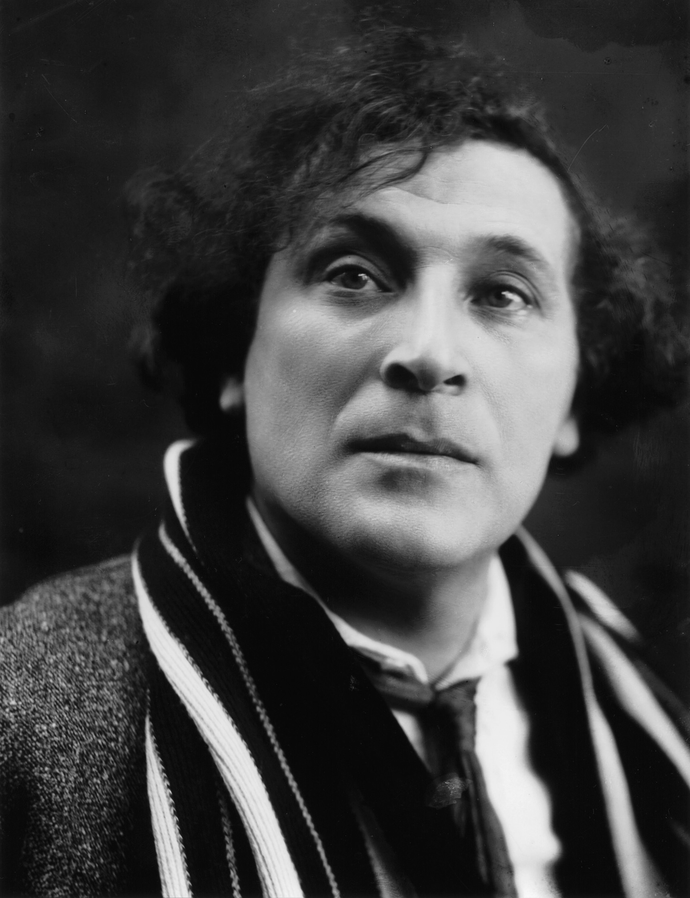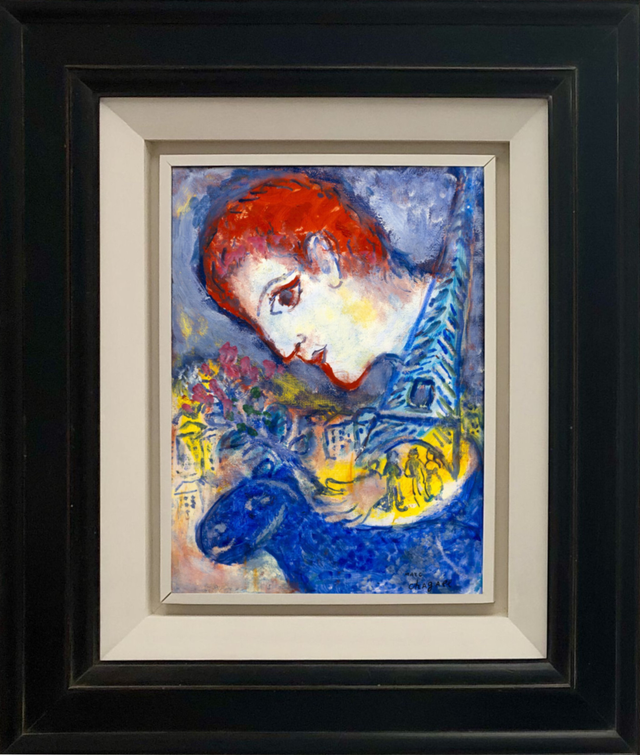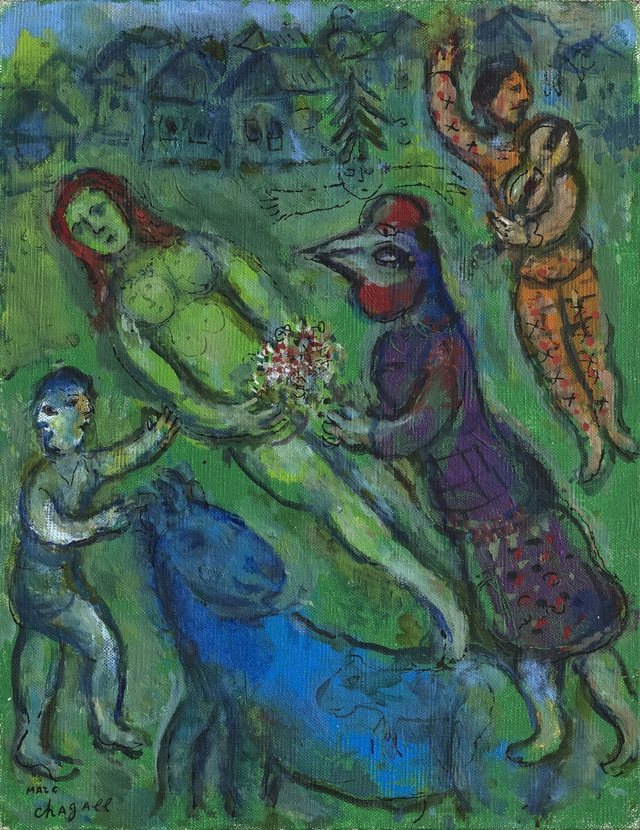
Marc Chagall
Marc Chagall was a Belarus-born French Modernist widely regarded as one of the most important and influential painters of the 20th century. His legacy includes numerous works across different techniques and media, such as painting, book illustrations, stained glass, ceramic, and fine art prints.
Biography of Marc Chagall
Marc Chagall, originally named Moishe Shagal, was born in 1887 in Liozna, near the city of Vitebsk, Belarus. The family name, Shagal, is a variation of Segal, associated with the Hebrew tribe of Levi, as per the Book of Genesis. Upon arriving in Paris in 1910, the artist adopted the pseudonym Marc Chagall in the French tradition.
The artist was the eldest of nine children and grew up in a financially poor yet affectionate Jewish family. His father, Khatskl (Zachar) Shagal, worked as a trader of pickled herring, while his mother, Feige-Ite, managed a shop selling groceries. The artist's brothers worked low-paying, unskilled jobs. Chagall attended a primary Jewish religious school, where he studied Torah and Talmud in Hebrew. Subsequently, he enrolled in a gymnasium where lessons were conducted in Russian.
At 19, Chagall joined the private School of Drawing and Painting, led by Yehuda Pen, one of the most prominent Jewish painters in the Russian Empire. Impressed by Chagall's bold use of colors, Pen allowed him to attend courses without charge.
Encouraged by his mother, Chagall relocated to Saint Petersburg in 1907, where he continued his artistic education under the guidance of Russian stage designer and artist Leon Bakst. In the same year, he became a member of the "Society of Art Supporters" school and studied under Nikolai Roerich. From 1908 to 1910, Chagall furthered his studies under Leon Bakst at the Zvantseva School of Drawing and Painting.
Life in Saint Petersburg proved challenging for Chagall. At that time, Jewish residents needed permission to live in Saint Petersburg, and Chagall was jailed for a brief period for violating this regulation. Despite these difficulties, he remained there until 1910.
In the summer of 1909, during one of his visits to his hometown, Chagall encountered the daughter of a local Jewish jeweler, Bella Rosenfeld. Despite her being only 14 years old, the couple fell in love at first sight. They married on July 25, 1915, and welcomed a daughter, Ida, in 1916. Marc and Bella remained together until Bella's untimely death.
In 1910, Chagall relocated to the capital of France, where he became a significant figure within the so-called École de Paris. He relied on a monthly stipend of 125 francs from the Russian-Jewish lawyer Maxim Vinaver for four years.
In Paris, Chagall met numerous writers and artists, including Guillaume Apollinaire, Robert Delaunay, and Albert Gleizes. Surrounded by this artistic community, the artist began developing poetic and innovative tendencies, and at the same time, he observed the emerging new styles of Fauvism, Cubism, and Surrealism. He drew inspiration from the Impressionist, Post-Impressionist, and Fauvist works displayed in Parisian museums.
Chagall actively participated in art exhibitions at the Salon des Indépendants and the Salon d'Automne in 1912. His inaugural solo exhibition took place at Herwarth Walden's Der Sturm Gallery in Berlin, Germany, establishing him as a leading international artist.
Due to his longing for Bella, who remained in his hometown, Chagall returned to Vitebsk in the spring of 1914. Initially planning to stay and marry her, their plans were disrupted by the outbreak of the Great War, leading to the indefinite closure of the borders and delaying their return to Europe.
Chagall and Bella were married in 1915, a time when the artist began showcasing his work in Moscow and, a year later, in St. Petersburg. Following his participation in a Moscow exhibition of avant-garde artists, Chagall gained attention from well-known collectors, leading to increased sales of his art. Concurrently, he started illustrating several Yiddish books with ink drawings, including I. L. Peretz's "The Magician" in 1917.
In 1918, Chagall assumed the role of Commissar for Art. The same year, he established the Vitebsk Popular Art School and served as its director for the next two years.
In 1920, Chagall, along with his wife and daughter, relocated to Moscow. There, he actively engaged in theatrical life by creating set drafts for performances, including stage decorations for the production of "Fiddler on the Roof," based on the story by the prominent Yiddish author and playwright Sholom Aleichem. Chagall executed his initial stage designs for the State Jewish Chamber Theater during this period.
In 1922, Chagall left Russia with his family, initially settling in Berlin for a year. During this time, he discovered that a significant number of the artworks he had left behind before the outbreak of the Great War in 1914 had been lost. In 1923, accompanied by his wife and daughter, Chagall relocated to Paris and would not return to Russia for over half a century. In Paris, Chagall encountered the French art dealer Ambroise Vollard, who commissioned him to create drawings and paintings depicting various religious scenes from the Old Testament and similar sources. Additionally, Chagall produced illustrations for "Dead Souls," a novel by Ukrainian author Nikolai Gogol.
Chagall's inaugural retrospective occurred in 1924 at the Galerie Barbazanges-Hodebert in Paris. His growing renown in artistic circles provided him with financial independence, enabling him to travel and explore various regions, including France, the Netherlands, Spain, Poland, and Italy, alongside his family.
In 1933, the Kunsthalle Basel organized a significant retrospective of Chagall's work. Subsequently, in 1937, the artist became a naturalized French citizen.
At the onset of World War II, the artist and his family fled to the USA, joining over 2,000 artists and intellectuals who were clandestinely transported out of Nazi-occupied territory to the United States through forged visas provided by a group of Americans running a rescue operation. They arrived in New York on June 23, 1941, just a day after Operation Barbarossa, the Nazi invasion of the Soviet Union.
While in the United States, Chagall continued to explore themes he had previously addressed in France until the passing of his wife and muse, Bella, in 1944. Following her death, depictions of memories of his beloved recurred in works such as "Around Her" (1945), "The Wedding Lights" (1945), and "Nocturne" (1947).
Following the death of his beloved Bella, Chagall experienced sadness and depression, which began to lift when he met Virginia Haggard-McNeil, an interpreter in French and the daughter of a former British consul. Marc and Virginia entered into a romance, resulting in the birth of their son David (McNeil) in 1946. Their relationship continued until 1952, when she left, taking their son with her.
In 1946, Chagall was honored with a significant retrospective exhibition at the Museum of Modern Art in New York, followed by another retrospective at the Art Institute of Chicago a few months later.
In the autumn of 1947, the artist returned to France. He attended the opening of his solo exhibition at one of the world's most visited art museums, the National Museum of Modern Art (Musée National d'Art Moderne) in Paris. Following the end of his relationship with Virginia in 1952, Chagall met Valentina "Vava" Brodskaya, who became his official wife. In the 1950s, he and Vava embarked on many journeys, particularly across the Mediterranean in Greece and Italy. Inspired by the wall paintings and icons characteristic of Mediterranean culture, the artist created a stunning color lithograph series entitled "Daphnis and Chloe." Based on the ancient Greek novel by Longus, the series captures the triumphs and tragedies of young love.
In the early 1960s, the government of Israel commissioned Chagall to create mosaics and tapestries for the Knesset building. The artist designed 12 floor mosaics, one wall mosaic, and three large, colorful Gobelin tapestries. The hall, named in honor of the artist, features the tapestries arranged as a triptych, with each part serving as both an integral component of the whole and a distinct unit representing the history of the Jewish people.
Following the tremendous success of The State Hall in Jerusalem, Chagall received numerous commissions to adorn churches and synagogues across Europe, the USA, and Israel. Notably, the Chagall windows at the synagogue of Hebrew University's Hadassah Medical Center in Jerusalem are regarded as one of Chagall's significant achievements in stained glass.
In 1963, André Malraux, France's Minister of Cultural Affairs, commissioned Chagall to paint a new ceiling for the Grand Opera in Paris. The ceiling consists of 12 canvas panels and a round central panel, totaling about two hundred and forty square meters and requiring 440 pounds of paint. The work is signed "Chagall Marc 1964" on the central panels, and it was inaugurated on September 23, 1964, in the presence of Malraux and more than two thousand guests.
Over the years, Marc Chagall became a master of stained glass, and his decorative windows can be found in numerous international locations. One of his most renowned stained-glass windows, titled "Peace," is situated at the United Nations building in New York. "Peace" was presented in 1964 as a memorial to Dag Hammarskjold, a Swedish diplomat and the second Secretary-General of the United Nations, who served from April 1953 until he died in a plane crash in September 1961.
Between 1978 and his death in 1985, Chagall created nine stained-glass windows for St. Stephan's Church in Mainz. Unique in Germany, these windows depict scenes from the Old Testament, illustrating the similarities between Christian and Jewish traditions.
Chagall's remarkable stained glass tribute to America, known as The America Windows, was installed at The Art Institute of Chicago in 1977. His last commissioned work, located on the north side of Chichester Cathedral and created when Chagall was 90 years old, was unveiled by the Duchess of Kent in 1978.
The Musée Marc Chagall is a French national museum in Nice, on the French Riviera, dedicated to Marc Chagall. Established during the artist's lifetime, the museum was inaugurated in 1973, celebrating Chagall’s life and work, particularly his pieces inspired by religion.
The artist continued to work energetically until his death on March 28, 1985, in Saint-Paul de Vence on the French Riviera at the age of ninety-seven. He was laid to rest in the local cemetery.
Marc Chagall's Art Style
Marc Chagall developed a distinctive artistic style by blending elements of Expressionism, Symbolism, Cubism, and other Modernist art movements.
Throughout his career, Bella Rosenfeld remained Chagall's first and greatest love, his wife and muse, serving as the subject of many of his paintings. One of the earlier works inspired by his beloved Bella is "The Birthday" (also known as "Anniversary"), painted in 1915. Filled with intimacy, affection, love, and warmth, this painting is now part of the permanent collection at the Museum of Modern Art in New York. Other pieces, including "Pink Lovers" (1916), "The Promenade" (1917-1918), "Bella with White Collar" (1917), and "Double Portrait with a Glass of Wine" (1917), are just a few examples featuring Bella Rosenfeld in Chagall's art.
Between 1953 and 1956, the artist produced his renowned Paris series, inspired by his deep affection for the city. In all the pieces from this series, a sequence of fantastical scenes unfolds against the backdrop of views of the French capital.
Starting in the 1960s, Chagall expanded his artistic repertoire to include monumental forms such as mosaics, stained glass windows, tapestries, sculpture, and ceramics.
Years:
Born in 1887
Country:
Belarus, Liozna
Gallery:
Galleria d'Arte Maggiore g.am.
Galerie Thomas
ACQUAVELLA
Landau Fine Art
Helly Nahmad Gallery

